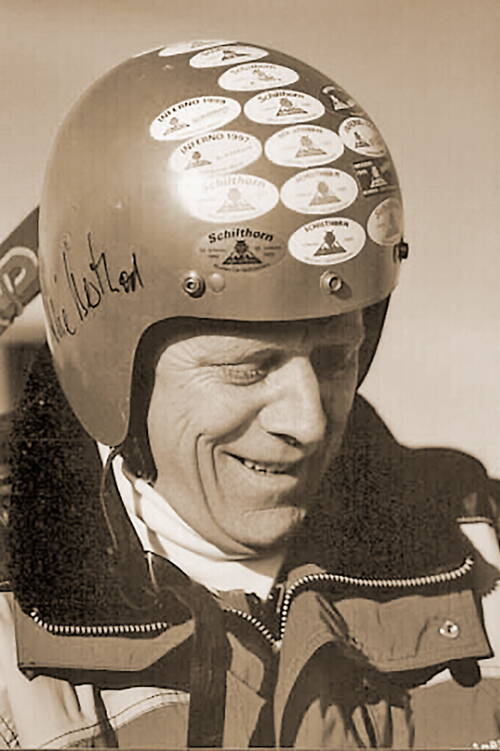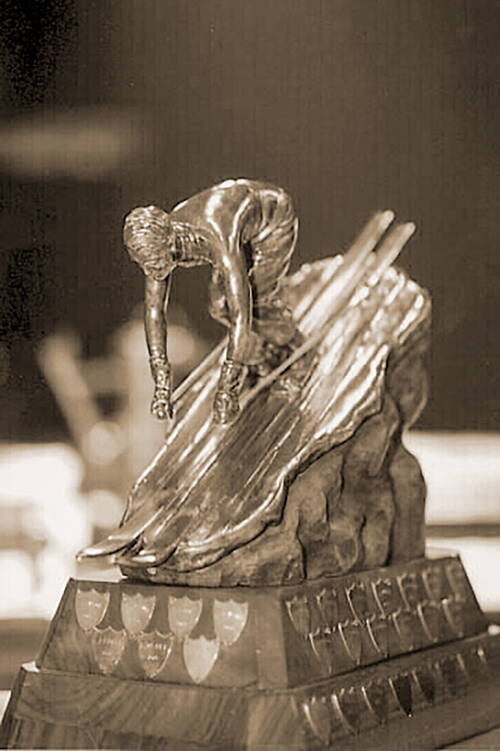History – a short version
The Inferno Race was held for the first time on 29 January 1928 with 17 competitors. Today it is one of the oldest surviving ski race in the world.
Sir Arnold Lunn of Britain - the father of Alpine ski racing - founded both the Arlberg Kandahar and the Inferno Race. In his book "The Kandahar Story", published in 1969, he wrote: "The Inferno remains today the only important Alpine race which is a real test of Alpine skiing, for though there is usually a piste down to Mürren, the rest of the race to Lauterbrunnen is almost always run on natural snow."
In the same book, Sir Arnold also described the first Inferno Race on 29 January 1928. The race started from the summit of the Schilthorn (2970 metres). All competitors started together and the starter was one of the skiers. "It was arranged", recalled Sir Arnold, "that those who did not want to race from the summit should join in as the competitors who started from the top swept past. The snow was, of course, 'untracked' and the course included a short climb and a langlauf section along the railway". The winner was Harold Mitchell, who covered the course in 1 hour 12 minutes. Doreen Elliott was the fastest woman from the four taking part. She lost nearly 10 minutes climbing back to help a competitor who had broken a rib - but she still finished in fourth place overall.
The organization at the finishing line consisted of one man, who had sprained his ankle and was therefore unable to compete. The day before the race, he synchronized his watch with that of Sir Arnold, who - on finishing in sixth place - informed him of the precise starting time. This enabled him to calculate the winning time.
In the following years (1929/30) the race was dominated by the British. It was only after a break of five years - when the Mürren Ski Club took over the organization - that the Inferno began to attract international acclaim. The event was again discontinued, due to the Second World War, but has been held every year since. The mass start gave way to the individual start, and the postwar participants were mainly local skiers as well as competitors from the military teams of Britain, France, Italy, the USA and Switzerland itself. Among the most prominent winners were C.E.W Mackintosh (Great Britain), Max Bertsch (Switzerland), Albert Gacon (France) and Bud Werner (USA).
The popularity of the Inferno did wane temporarily due to the increasing number of international skiing events. And the end of the race was predicted when, in 1967, the Schilthorn Aerial Cableway (the longest and most modern in the world at that time) began operation up to the Schilthorn. But the opening of the cableway in fact had the opposite effect. The Start was easier to access and competitors could now inspect the course. The Regulations at that time remained unchanged so the terrain was still partly untracked. Only three control gates were installed, so that the skier's choice of line was left largely open. As a result, the Inferno Race enjoyed an unexpected revival at international level.
At the beginning of the 70s, the decision was made in Mürren to leave the Arlberg Kandahar World Cup races and to open it to everyone and promote the inferno race. The Inferno race became the first „Volkskirennen“. The number of participants rose from 300, and were limited to 1450 in 1980. The team race for the „Sir Arnold Lunn Cup“, which has been held since 1975, has also contributed to this increase. In 1998, the maximum number of participants was increased to 1850, with a few hundred applicants are still being rejected each year.
Technical progress has meant that the whole route can now be prepared with the piste machines. Over the years the number of control gates has been raised for safety reasons. Timekeeping has evolved over the years from the synchronized watches to the latest technologies. Today, each competitor has a chip attached to the starting number which not only gives a time, but can also provide two intermediate times.
In 1985, the Inferno race completed the first Inferno-Super-Combination consisting of a cross-country race, a giant slalom and the downhill. Since 2003, the cross country race has taken part as a night race around the Mürren village.
Today the Inferno can be considered the Alpine parallel to the „Vasalauf“ amateur event which enjoy such great popularity among Nordic skiers. Participation takes priority over position, and anyone wearing the coveted Inferno Badge (the Devil) can take pride in counting himself - or herself - among the best skiers in the world.
Honorary President, Kurt Huggler


